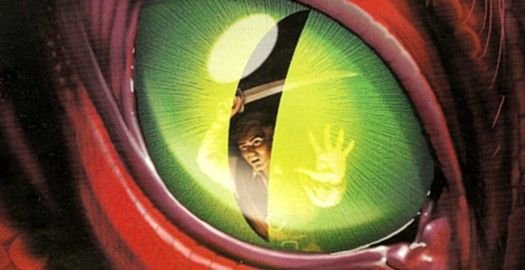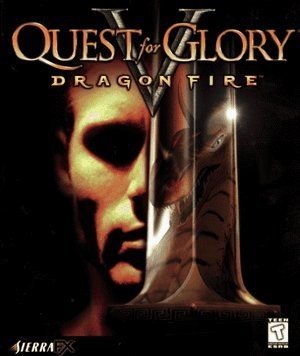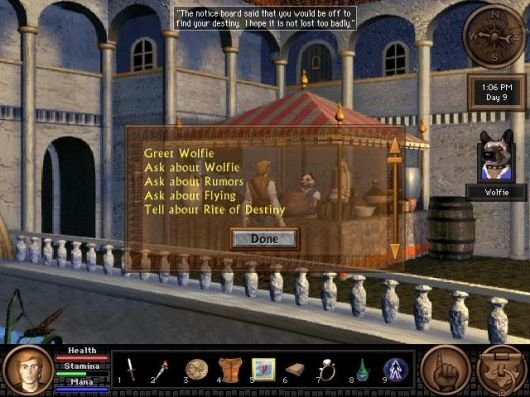Review for Quest for Glory V: Dragon Fire

Game information
Before there ever was a Quest for Glory V: Dragon Fire, there was... the quest for Quest for Glory V. When Sierra opted to discontinue the Quest for Glory series after releasing the fourth instalment, Shadows of Darkness, the decision prompted a significant public outcry. In a time when the Internet was still a relatively new phenomenon for most gamers, series fans seized the opportunity to form an online coalition, rallying for organized boycotts of Sierra products, petitions and e-mail writing campaigns. Convinced at last that the series still had a viable following, Sierra ultimately gave in to the protests and Dragon Fire was made a reality, though not without some notable changes, and not all of them successful.
For the series’ final instalment, Lori Ann Cole was asked to return as designer. Given a substantial budget, she chose to aim high, with an expensive new 3D engine and a fully orchestrated score. She also envisioned it as a sophisticated multiplayer game with different playable characters and expansion packs to be released later, but these goals were eventually dropped. Yet this disappointment didn’t stop Cole from being ambitious, as Dragon Fire is a departure from its predecessors in various ways, though still remaining true to the original design ideas laid out ten years earlier.
Dragon Fire opens with a clever introduction sequence. Players are given an account of the past, present and grim-looking future of a kingdom called Silmaria, as narrated by the country’s king mere moments before he is murdered by an assassin. We learn that ages ago, Silmaria was terrorized by a fire-breathing dragon. Unable to destroy the beast, it was instead bound by magic to stay in its lair, laying dormant. Years of peace followed, and most people have forgotten about those times of chaos. One person, however, sees the dragon as the key to gaining control over the kingdom, and as this villain now seeks to release it, Silmaria is terrorized by armies of foreign invaders. Powerless to mend the situation, the king realizes that only a Hero will be able to save his kingdom. With these grave thoughts recounted, his throat is slit and the stage is set for Dragon Fire to begin.
In this time of need, the friendly wizard Erasmus, whom we met in Quest for Glory I, summons the series’ protagonist to the kingdom. So once again we find ourselves in an entirely new culture, as Dragon Fire takes us to the Greek-themed city of Silmaria with its pleasant winter climate. The Island of Marete is set in the Quest for Glory-equivalent of the Mediterranean Sea, and Silmaria appears to be a relaxed and laid-back destination, filled with people to see, things to do and places to visit. No one seems aware of an ancient dragon that may pose a threat, and though word of invaders has scared many townspeople into fleeing, the danger still seems distant and the remaining inhabitants don’t appear disturbed at all.
Erasmus is but the first of many familiar faces that the Hero meets in Silmaria. Another friend encountered early is the noble Liontaur Paladin Rakeesh, and both he and the wizard want us to enter the Rites of Rulership, through which the next king will be chosen. Contenders for the throne are required to compete in a series of quests, and the winner claims the crown. The hope is that by competing in these Rites, we might be able to discover who killed the previous king and why.
The moment the Hero enters the competition is when the actual plot is set in motion, but you’re advised to take some time to relax first, and it is amazing how free you are to explore the island before the Rites begin. You can spend hours (or weeks, in game time) solving quests and puzzles, meeting people, fighting, competing in minigames and practicing your skills before the main action kicks off. Alternatively, you can enter the Rites of Rulership immediately and explore later as the story progresses. This game offers a lot of freedom, which is certainly one of its major strengths.
Dragon Fire also presents the most expansive world in any Quest for Glory game. A large number of diverse locations spread out over different islands can be visited, all displayed in lush and colourful pre-rendered 3D graphics, from panoramic blue beaches with vivid green palm trees to majestic valleys with high mountain peaks. All backgrounds are nicely designed, but some are truly outstanding, showing bright, clear graphics with plenty of artistic detail. A few locales seem somewhat artificial, however. One area in particular, Silmaria’s so-called Science Island, feels very out of place in a medieval fantasy-themed game with its modern, electronic look.
A downside to the scenic nature of these backgrounds is that most are completely zoomed-out to fully display their splendour, which makes two crucial hotspots rather difficult to discover and the characters look small and distant. Though the polygonal character models are of decent quality, they often look grainy from being scaled to such a small size. Also, most supporting characters are poorly animated or not at all, making them appear lifeless.
Small character portraits do appear during conversations, but the poor overall visual presentation of Silmaria’s inhabitants is a missed opportunity, since the game features a lot of dialogue. In fact, there is so much optional dialogue that you could spend hours just talking to people, only a minority of which are human. Most characters have an interesting story to tell, like the fisherman Andre or the somewhat incompetent Gnome innkeeper Ann. Many also offer a sidequest as the game progresses, and will often respond to the various events that occur, which greatly helps to make the world feel dynamic. Voiceovers are handled very well, as both the serious and the humourous personalities are conveyed by suitably matched actors. The voice of the art seller Wolfie in particular had me laughing with almost every line.
The dialogue and narration – which isn’t voiced this time around – is as cleverly written as ever. Still, while Shadows of Darkness shone with an intriguing plot supported by well-developed characters, Dragon Fire disappoints in these categories. The characters are amusing to talk with, and you’ll find yourself continually going back to many of them to check if they have anything new to say just for fun, but they ultimately lack any depth and significance to the overall storyline.
One new character development this time around is the option of marriage. There are four women in the game that you can pursue and end up marrying. Though the ceremony won’t actually happen during the course of this game, the fact that you can propose and get engaged is an interesting feature, especially since the courtship becomes a sidequest in itself. As one of the many subplots, it is a nice example of the nonlinearity and replayability of Dragon Fire, as the outcome of choices you make in certain events, as well as the quests you complete, influence the game world, its characters and possibly even the final outcome.
Unfortunately, the Greek setting never seems believable, nor does it manage to create an immersive atmosphere, partly because the indigenous Silmarians are vastly outnumbered by people from all over the world. The city sometimes feels more like a seaside resort where all the Hero’s old pals are hanging out rather than an ancient city-state. The references to Greek mythology, such as Pegasus and the Sibyl, feel forced, and the lack of connection with the residents ultimately makes the presence of these legendary beings irrelevant and expendable.
The same issue is sometimes true of the game’s music, as some songs don’t seem to fit in well with specific locations. That’s the only negative thing I’ll say about the score, however, since otherwise it is excellent. Chance Thomas used a full orchestra to perform the music, which gives the game a feeling of grandeur throughout. Calmer settings are accompanied by gentle flutes and Greek-sounding guitars, while combat scenes are driven by bombastic horns, strings and drums. There is one scene where the Hero dances in a Dryad’s grove, which is enchanting in its splendid use of graphics and a beautiful symphony by Thomas. Overall, Dragon Fire’s soundtrack rivals that of many top movies in quality.
The main focus of the game is a series of seven tasks, the Rites, which range from fetch quests in Hades and Atlantis to a number of missions in which you’re sent out to kill a certain creature or person. When competitors start being assassinated much the same way the king was murdered, it becomes ever more apparent that someone evil is after the throne of Silmaria. The problem here is that the story recycles a plotline from three previous games, making it feel shallow and uninspired. Not only is the villain’s scheme unoriginal, the way it’s executed is somewhat illogical, so uncovering Dragon Fire’s secrets probably won’t leave you satisfied.
On the other hand, storytelling isn’t really the main focus here. Dragon Fire basically employs its plot as an excuse to send the player on a bunch of smaller quests, which thankfully are fairly diverse and manage to entertain. It should be noted, however, that these missions generally involve killing rather than solving puzzles. Though the game does offer plenty of traditional puzzles, the combat elements are expanded to such a degree that the game feels more like an RPG with a few adventure game elements mixed in than the other way around, as was the case in previous games.
Item use is handled somewhat awkwardly by a ‘belt’ system. The inventory can be accessed through a special button onscreen. While open, objects can be used on each other, but when you want to use items in the game world, you first need to drag them to the belt, which is basically a quick bar at the bottom of the screen that can hold nine items. Once the inventory is closed, you can then select items in the belt to interact with them. You can also use the belt to equip and unequip weapons and armor, as well as cast spells much the same way as you use items.
The series’ trademark option for the different character classes to overcome obstacles in unique ways has diminished a bit too. Not only are there fewer puzzles designed with this structure in mind, many are reiterations of similar puzzles in previous games. It used to be interesting to have one character get past a locked gate by magic, another by brute force, and the third by using thief skills, but the process has become a little repetitive at this point. It’s disappointing to see a once-inventive facet of the series grow old; a telltale sign that Quest for Glory was stretching its lifespan thin with the fourth sequel.
The skill challenges, in which you are required to practice abilities like throwing or climbing, likewise have become stale and lack creativity. That the walls and cliffs are much taller now doesn’t make up for the fact you’re still using the same solution to overcome similar hindrances as in previous games. The issue isn’t that these challenges have all of a sudden become a nuisance, but that they lack any originality to keep the experience fresh. Thankfully, there are also many normal inventory puzzles that are well designed and require creative thinking, such as the crafting of a flying balloon.
Quest for Peace? Part 5
Much more than its predecessors, Dragon Fire emphasizes action and fighting. You’ll encounter many combat situations in Silmaria, even during the so-called ‘Rite of Peace’. However, for the most part the series continues to be only as violent as you want it to be.
Several of the challenges that confront you with small armies of monsters can be completed without actually resorting to fighting. You can often just walk past enemies when on a fetch quest, for example. That said, it is often much easier to just kill enemies when they get in your way, especially when the difficulty is set to the easiest setting, which should make combat very little problem for anyone.
While many can be avoided, Dragon Fire does feature plenty of obligatory combat scenes, and should appeal least to the adventure purist. Fortunately, even major enemies can be killed with just a few well-placed mouse clicks if your skills are adequately trained.
Dragon Fire’s point-and-click interface basically has two functions: By right-clicking you can switch your cursor between interacting and looking. Unfortunately, the interact icon is used for every possible action: walking, picking things up, talking, and fighting. When in combat, you may be frantically clicking on a monster to attack it, then accidentally click on another object nearby or behind it, only to have the Hero move to that object. Or you may be fighting one enemy when another moves in, blocking your view and preventing you from clicking on your previous target. It is possible to use keyboard controls for fighting, but this comes with its owns problems. It’s more difficult to manoeuvre that way, and you can’t always accurately determine which direction the Hero is facing.
One method of bringing variety into a fight is to use magic. Since you are free to move around the screen during combat, this allows for spells to be used in different ways. It’s possible to run away from enemies and strike them from a distance, or use area-affecting spells to strike multiple targets at once. You can even use some spells to distract enemies or set up an explosive trap-like spell. It doesn’t always pay off to do so, however. Despite its problems, combat isn’t actually very difficult, so it’s a bit superfluous to bother with much strategy. Even when setting the difficulty to the highest level, it is probably still quickest to stay on the offensive with weapons and direct spells. Alternatively, combat can often be approached like a stealth game for Heroes with thief skills. There is more opportunity to sneak around now, and for the first time in the series a blackjack becomes available, which allows you to sneak up on enemies and take them out in one blow – if your skill is developed sufficiently, of course.
The ability to sneak around and cast spells in new ways are welcome additions, as is the arsenal of new weapons, armor, and magical equipment. It is through experimenting with these new features that you may have some fun with combat in Dragon Fire, since each battle can be approached differently. Of course, for those with any tolerance for combat, fighting monsters has its own hack-and-slash appeal, but since the combat system is so basic, don’t expect to be rewarded for using any real tactics.
From the moment this series was rescued from cancellation, Dragon Fire was designed as an epilogue – one last adventure that would allow the Hero to shine once more before bidding a fond adieu. With many old friends and acquaintances returning, it was specifically intended to offer closure, as the Hero may end up married or even as king, depending on your actions. It is disappointing, then, that the very end of the game is quite bland. Though it does manage to bring a pleasant closure to the series, the final moments won’t leave you particularly satisfied, which is a missed opportunity for a grand and fitting farewell.
For those new to the series, Dragon Fire might actually be a good place to pick the series up. Its laid-back beginning and freedom to explore allow new players to familiarize themselves with both the game world and the adventure/RPG concept at their leisure. Those that are eager for combat can get into the action right away, while others will find themselves in the middle of Silmaria with a host of different characters. Though much of the supporting cast is returning from previous games, your new interactions with them don’t rely on existing familiarity. Perhaps just as importantly, Dragon Fire should run fine on most modern systems, whereas the older games rely on fan-patches and emulators to run smoothly.
In any case, both players new and old should find something to entertain them in the appealing humour, well-written dialogue, a bit of monster bashing, and the many quests and other activities available. The game may not excel in any one area, and it is much more of an action-driven game than ever before, but none of its weaknesses are enough to spoil the fun that can be found. The characters may lack depth, but that won’t stop you from laughing with them. The setting might not seem fully developed, but still provides a diverse world filled with various creatures and locations. And the plot may lack originality, but it nevertheless conveys an amusing tale of betrayal, adventure and heroism. With Quest for Glory V: Dragon Fire, then, the dreams of a revived series came true in perhaps an unexpected way, but it’s certainly worth one last adventure to properly say goodbye.
































